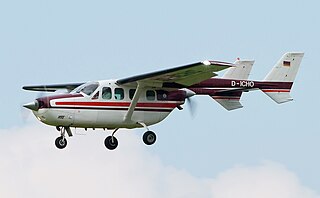Dedham is a town in Hancock County, Maine, United States. The population was 1,648 at the 2020 census. The town includes the site of a Cold War airplane crash on Bald Mountain.

The Douglas C-54 Skymaster is a four-engined transport aircraft used by the United States Army Air Forces in World War II and the Korean War. Like the Douglas C-47 Skytrain derived from the DC-3, the C-54 Skymaster was derived from a civilian airliner, the Douglas DC-4. Besides transport of cargo, the C-54 also carried presidents, prime ministers, and military staff. Dozens of variants of the C-54 were employed in a wide variety of non-combat roles such as air-sea rescue, scientific and military research, and missile tracking and recovery. During the Berlin Airlift it hauled coal and food supplies to West Berlin. After the Korean War it continued to be used for military and civilian uses by more than 30 countries. It was one of the first aircraft to carry the President of the United States, the first being President Franklin D. Roosevelt during World War II.

The Douglas DC-4 is an American four-engined (piston), propeller-driven airliner developed by the Douglas Aircraft Company. Military versions of the plane, the C-54 and R5D, served during World War II, in the Berlin Airlift and into the 1960s. From 1945, many civil airlines operated the DC-4 worldwide.
This is a list of aviation-related events from 1947:
This is a list of aviation-related events from 1950:
This is a list of aviation-related events from 1953:
This is a list of aviation-related events from 1976.

The Cessna Skymaster is an American twin-engine civil utility aircraft built in a push-pull configuration. Its engines are mounted in the nose and rear of its pod-style fuselage. Twin booms extend aft of the wings to the vertical stabilizers, with the rear engine between them. The horizontal stabilizer is aft of the pusher propeller, mounted between and connecting the two booms. The combined tractor and pusher engines produce centerline thrust and a unique sound. The Cessna O-2 Skymaster is a military version of the Cessna 337 Super Skymaster.

American Overseas Airlines (AOA) was an airline that operated between the United States and Europe between 1945 and 1950. It was headquartered in Midtown Manhattan, New York City.
Fort Mountain is a mountain located in Piscataquis County, Maine, within Baxter State Park. Fort Mountain is flanked to the southeast by North Brother Mountain, and to the north by Mullen Mountain. Although officially trailless, a well-defined herd path leads to the summit of Fort from North Brother.
The Conroy Stolifter was a conversion of the Cessna 337 Super Skymaster, developed by John M. Conroy of Conroy Aircraft starting in 1968.
Air Ferry Limited was a private, independent British airline operating charter, scheduled and all-cargo flights from 1963 to 1968.

L'Oiseau Blanc was a French Levasseur PL.8 biplane that disappeared in 1927 during an attempt to make the first non-stop transatlantic flight between Paris and New York City to compete for the Orteig Prize. French World War I aviation heroes Charles Nungesser and François Coli took off from Paris on 8 May 1927 and were last seen over Ireland. Less than two weeks later, Charles Lindbergh successfully made the New York–Paris journey and claimed the prize in the Spirit of St. Louis.
There are a number of wind power projects in the state of Maine, totaling more than 900 megawatts (MW) in capacity. In 2020 they were responsible for 24% of in-state electricity production. In 2019, Maine had more wind capacity than the other five New England states combined, at 923 MW.

On 24 January 1963 a United States Air Force Boeing B-52C Stratofortress with nine crew members on board lost its vertical stabilizer due to buffeting stresses during turbulence at low altitude and crashed on Elephant Mountain in Piscataquis County, Maine, United States, six miles (9.7 km) from Greenville. The pilot and the navigator survived the accident.
The crash of TWA Flight 8 involved a Transcontinental & Western Air Douglas DC-2. On March 1, 1938, during a scheduled passenger flight from San Francisco to Winslow, Arizona, TWA's interstate hub, the flight encountered severe weather. The pilot radioed his intention to land in nearby Fresno. The aircraft subsequently crashed on a mountain in Yosemite National Park, and was found three months later.
This is a partial list of accidents and incidents involving the Boeing-designed B-17 Flying Fortress. Combat losses are not included except for a very few cases denoted by singular circumstances. A few documented drone attrition cases are also included.

On 26 January 1950, the Douglas C-54 Skymaster serial number 42-72469 disappeared en route from Alaska to Montana, with 44 people aboard. The aircraft made its last radio contact two hours into its eight-hour flight. Despite one of the largest rescue efforts carried out by a joint effort between Canadian and US military forces, no trace of the aircraft has ever been found.







